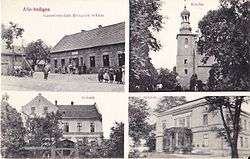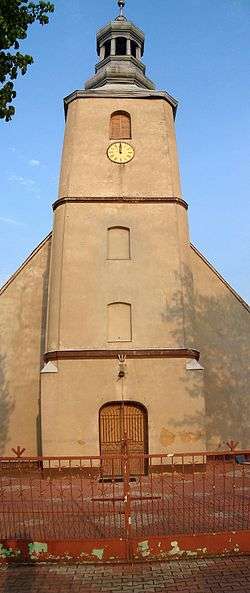Wszechświęte, Lower Silesian Voivodeship
Wszechświęte [fʂɛxɕˈfjɛntɛ] (German: Allerheiligen) is a village in the administrative district of Gmina Oleśnica, within Oleśnica County, Lower Silesian Voivodeship, in south-western Poland.[1] Prior to 1945 it was in Germany.
The village lies approximately 8 kilometers (5 mi) east from Oleśnica.
Wszechświęte | |
|---|---|
Village | |
 Wszechświęte | |
| Coordinates: 51°11′30″N 17°29′05″E | |
| Country | |
| Voivodeship | Lower Silesian |
| County | Oleśnica |
| Gmina | Gmina Oleśnica |
| Established | 14th century |
| Area | 3,986 km2 (1,539 sq mi) |
| Elevation | 126 m (413 ft) |
| Population | 235 |
| Postal code | 56-400 |
| Car plates | DOL |
Organizations
In the village there are three organizations
- Folk music band "Wianki" ("Wreaths")
- Volunteer fire department
- Football team

Postcard from Wszechświęte of 1930

The Church in the village Wszechświęte
Area
Village Wszechświęte occupies an area of 398,55 hectares, of which 358,48 hectares is agricultural land.
The overall area consists of:
- arable land - 311,91 ha
- meadows - 31,75 ha
- pastures -12,81 ha
- orchards - 2,01 ha
- built-up areas - 10,49 ha
- forests - 7,77 ha
- water - 3,54 ha
- road - 16,59 ha
- waste land - 1,60 ha
Names
Village has changed names three times over the years:
- 1317 - Omnium Sanctorum (Latin for All Saints)
- 1376 - Alle Heilig (German: All Saints)
- 1785 - Allerheiligen
History
- 1317 - first mention. Berold, the parish priest in the village Wszechświęte was mentioned in a document concerning a dispute about tithes
- 1376 - village mentioned, as established under German law
- 1380 - in the village was a manor owned by Pecko Krompusch
- 1597 - the evangelical minister Bartolomeus Glassius was mentioned
- 1705 - old church was completely rebuilt (realized by evangelical community)
- 1785 - in the village school and folwark began to operate. The village had 143 inhabitants, 3 farmstead farms, 13 farmsteads, 3 cottages
- 1819 - Von Hautcharmoi sold his fortune to von Schickfus family
- 1845 - the owner of the village was a deputy of the court in Oleśnica - Gustaw Moritz von Schickfus. There were parish, a palace, a windmill, a horse-powered mill in the village. All 27 farms were inhabited by 281 people (3 Catholics, 7 Judaists) of which 15 craftsmen and tradesmen. In the village there was an evangelical school.
- 1874 - in the village were 24 farms, inhabited by 149 people (9 Catholics).
- 1860 - building of the palace, and establishment of the park
- 1876 - estate was owned by Hermann von Wiessel. The estate covered 236 hectares of land
- 1891 - the next owner of the estate was Dr. Phil Kurt Seidler
- 1908 - village had 30 houses, 189 inhabitants (23 Catholics)
- 1909 - the property was in the hands of the lawyer and deputy district, Wilhelm Krüger. The property area covered 300 hectares of land, including a park and garden of 6 hectares, 4 hectares of farmland. The owner also had a distillery and sugar factory. This state lasted until 1945
- after 1945 - the property was parceled out between the individual users
References
This article is issued from Wikipedia. The text is licensed under Creative Commons - Attribution - Sharealike. Additional terms may apply for the media files.